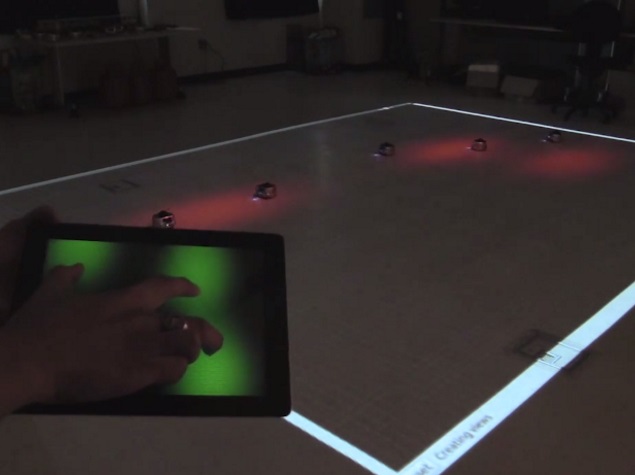- Home
- Science
- Science News
- New Algorithm Enables Control Over Swarms of Robots With Swipe of a Finger
New Algorithm Enables Control Over Swarms of Robots With Swipe of a Finger

"It's not possible for a person to control a thousand or a million robots by individually programming each one where to go. Instead, the operator controls an area that needs to be explored. Then the robots work together to determine the best ways to accomplish the job," said lead researcher professor Magnus Egerstedt, from Georgia Tech.
A person taps the tablet to control where the beam of light appears on a floor. The swarm robots then roll toward the illumination, constantly communicating with each other and deciding how to evenly cover the lit area.
When the person swipes the tablet to drag the light across the floor, the robots follow. If the operator puts two fingers in different locations on the tablet, the machines will split into teams and repeat the process.
Egerstedt envisions a scenario in which an operator sends a large fleet of machines into a specific area of a tsunami-ravaged region.
The robots could search for survivors, dividing themselves into equal sections. If some machines were suddenly needed in a new area, a single person could quickly re-deploy them.
Georgia Tech claims its model is different from many other robotic coverage algorithms because it's not static. The new model is flexible enough to allow robots to "change their minds" effectively, rather than just performing the single job they're programmed to do.
"The field of swarm robotics gets difficult when you expect teams of robots to be as dynamic and adaptive as humans," Egerstedt explained.
"People can quickly adapt to changing circumstances, make new decisions and act. Robots typically can't. It's hard for them to talk and form plans when everything is changing around them," he added.
In the Georgia Tech demonstration, each robot is constantly measuring how much light is in its local "neighbourhood".
It's also chatting with its neighbour. When there's too much light in its area, the robot moves away so that another can steal some of its light.
"The robots are working together to make sure that each one has the same amount of light in its own area," Egerstedt said.
What is more interesting is that anyone can control the robots, even if they don't have a background in robotics.
"In the future, farmers could send machines into their fields to inspect the crops," said Georgia Tech Ph.D. candidate Yancy Diaz-Mercado.
The study was published in the IEEE Transactions on Robotics (T-RO).
Catch the latest from the Consumer Electronics Show on Gadgets 360, at our CES 2026 hub.
Related Stories
- Samsung Galaxy Unpacked 2025
- ChatGPT
- Redmi Note 14 Pro+
- iPhone 16
- Apple Vision Pro
- Oneplus 12
- OnePlus Nord CE 3 Lite 5G
- iPhone 13
- Xiaomi 14 Pro
- Oppo Find N3
- Tecno Spark Go (2023)
- Realme V30
- Best Phones Under 25000
- Samsung Galaxy S24 Series
- Cryptocurrency
- iQoo 12
- Samsung Galaxy S24 Ultra
- Giottus
- Samsung Galaxy Z Flip 5
- Apple 'Scary Fast'
- Housefull 5
- GoPro Hero 12 Black Review
- Invincible Season 2
- JioGlass
- HD Ready TV
- Laptop Under 50000
- Smartwatch Under 10000
- Latest Mobile Phones
- Compare Phones
- OPPO Reno 15 Pro Max
- Honor Win RT
- Honor Win
- Xiaomi 17 Ultra Leica Edition
- Xiaomi 17 Ultra
- Huawei Nova 15
- Huawei Nova 15 Pro
- Huawei Nova 15 Ultra
- Asus ProArt P16
- MacBook Pro 14-inch (M5, 2025)
- OPPO Pad Air 5
- Huawei MatePad 11.5 (2026)
- Xiaomi Watch 5
- Huawei Watch 10th Anniversary Edition
- Acerpure Nitro Z Series 100-inch QLED TV
- Samsung 43 Inch LED Ultra HD (4K) Smart TV (UA43UE81AFULXL)
- Asus ROG Ally
- Nintendo Switch Lite
- Haier 1.6 Ton 5 Star Inverter Split AC (HSU19G-MZAID5BN-INV)
- Haier 1.6 Ton 5 Star Inverter Split AC (HSU19G-MZAIM5BN-INV)
















